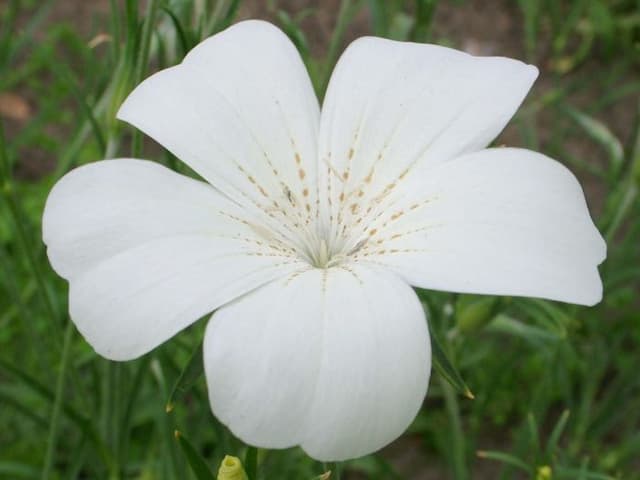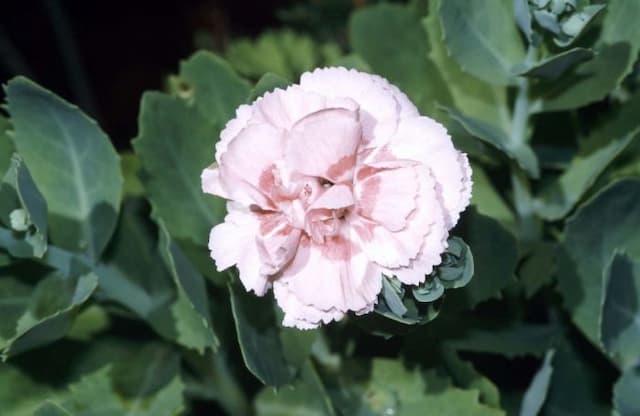Ragged robin 'White Robin' Lychnis flos-cuculi 'White Robin'

ABOUT
an upright perennial to 70cm, with branched stems bearing opposite, lance-shaped leaves and, in late spring and early summer, terminal clusters of star-shaped white flowers, each petal deeply cut intofour narrow segments
About this plant
 Names
NamesFamily
Caryophyllaceae.
Synonyms
Ragged Robin, Cuckoo Flower, Meadow Campion, White Robin.
Common names
Silene flos-cuculi, Melandrium flos-cuculi.
 Characteristics
CharacteristicsLife cycle
Perennials
Foliage type
Deciduous
Color of leaves
Green
Flower color
White
Height
2 feet (60 cm)
Spread
1 foot (30 cm)
Plant type
Herb
Hardiness zones
4
Native area
Europe
Benefits
 General Benefits
General Benefits- Attracts Pollinators: This plant is known to attract bees, butterflies, and other beneficial insects to the garden, aiding in the pollination of plants.
- Aesthetic Appeal: With its delicate white blooms, it adds visual interest and beauty to garden spaces and landscapes.
- Low Maintenance: Lychnis flos-cuculi is generally easy to care for, requiring minimal maintenance once established.
- Drought Tolerance: It is relatively tolerant to drought, making it suitable for gardens with drier conditions.
- Wildlife Habitat: Provides food and habitat for a variety of wildlife, enhancing biodiversity within its ecosystem.
- Seasonal Interest: Offers seasonal blooms that can help maintain visual appeal in a garden throughout different seasons.
 Medical Properties
Medical Properties- This plant is not used for medical purposes.
 Air-purifying Qualities
Air-purifying QualitiesThis plant is not specifically known for air purifying qualities.
 Other Uses
Other Uses- Ragged Robin can be planted to attract pollinators like bees and butterflies to the garden, which is essential for the pollination of many other plants.
- It's also used in meadow or wildflower gardens to provide a naturalized aesthetic, adding visual interest and supporting biodiversity.
- The flowers of Ragged Robin can be used in floral arrangements adding a delicate and whimsical touch to bouquets.
- This plant can be used to stabilize soil in wetland restoration projects, as it's tolerant to wet soil conditions.
- Ragged Robin is sometimes used in educational settings to teach about native plant species and their role in local ecosystems.
- The plant can be used in rain gardens which are designed to absorb rainwater runoff from roofs, driveways, and walkways.
- Its dense foliage can provide a modest degree of ground cover, helping to suppress weeds around the garden.
- Ragged Robin can be used to create a cottage garden look, which is a style characterized by informal design, traditional materials, dense plantings, and a mixture of ornamental and edible plants.
- In photography and fine art, the distinct structure of Ragged Robin flowers can be a subject for emphasis on texture and form within naturalistic compositions.
- As a component of a wildlife garden, Ragged Robin can provide essential habitat for small insects, which in turn can be a food source for birds and other wildlife.
Interesting Facts
 Feng Shui
Feng ShuiThe Ragged Robin is not used in Feng Shui practice.
 Zodiac Sign Compitability
Zodiac Sign CompitabilityThe Ragged Robin is not used in astrology practice.
 Plant Symbolism
Plant Symbolism- Delicacy: The Lychnis flos-cuculi 'White Robin', commonly known as "Ragged Robin", has a delicate and frilly appearance, reflecting qualities of fragility and a gentle nature.
- Adaptability: This plant can thrive in a variety of conditions, symbolizing the ability to adapt and flourish in different environments.
- Pure Love: The color white often represents purity, and in the context of the 'White Robin', it may symbolize pure and unblemished love.
- Intuition: Some folk traditions hold that Ragged Robin is associated with intuition and psychic abilities, perhaps due to its otherworldly appearance.
 Water
WaterRagged Robin should be watered regularly to maintain a consistently moist soil environment, especially during its active growing season in spring and early summer. Typically, water this plant when the top inch of soil begins to feel dry to the touch. Depending on weather conditions and soil drainage, this could mean watering approximately once or twice a week. Be cautious to avoid over-watering, as this can lead to root rot. Established plants will generally require about 1 gallon of water per plant per week, although this can vary depending on climate conditions and soil type.
 Light
LightRagged Robin thrives best in full sun to partial shade. Ideally, place it in a spot where it can receive at least 6 hours of sunlight a day. While it can tolerate some shade, too little light may reduce flowering and lead to leggy growth.
 Temperature
TemperatureThe Ragged Robin prefers temperate climates with temperatures typically ranging between 60 to 75 degrees Fahrenheit during its growing season. It can tolerate minimum temperatures down to around 20 degrees Fahrenheit and maximum temperatures up to about 85 degrees Fahrenheit. The ideal temperature range promotes healthy growth and optimal flowering.
 Pruning
PruningPruning Ragged Robin is important for maintaining plant health and encouraging bushier growth. Deadhead spent flowers to promote additional blooming. Cut back the foliage in late fall or early spring to help rejuvenate the plant and prevent it from becoming too leggy. Pruning is typically needed once per year or after the blooming cycle has completed.
 Cleaning
CleaningAs needed
 Soil
SoilRagged Robin 'White Robin' prefers a soil mix with good drainage, enriched with organic matter and with a neutral to slightly alkaline pH, between 6.5 to 7.5.
 Repotting
RepottingRagged Robin 'White Robin' typically doesn't require frequent repotting and can be repotted every 2-3 years to refresh the soil.
 Humidity & Misting
Humidity & MistingRagged Robin 'White Robin' does well in average humidity conditions and does not require any special humidity adjustments.
 Suitable locations
Suitable locationsIndoor
Place in bright, indirect light and maintain moderate soil moisture.
Outdoor
Plant in partial shade, ensure well-drained soil, tolerate cold.
Hardiness zone
3-9 USDA
 Life cycle
Life cycleThe life cycle of Lychnis flos-cuculi 'White Robin', commonly known as Ragged Robin, begins with seed germination that takes place in moist soils with good sunlight. After germination, the seedlings grow into juvenile plants, developing a rosette of leaves at the ground level. As the plant matures, it develops a flowering stem with the distinctive, fringed white flowers that bloom in late spring to early summer. Following pollination, typically by insects attracted to the flowers, the plant sets seed in capsule-like fruits that disperse when mature. After seeding, the plant may die back in areas with cold winters, surviving as a perennial through its root system and producing new growth in the following spring. Throughout its life, Ragged Robin can spread through self-seeding and occasionally by vegetative means if portions of the root are disturbed and become established elsewhere.
 Propogation
PropogationPropogation time
Spring to Summer
Propogation: The most popular method of propagating Lychnis flos-cuculi 'White Robin', commonly known as Ragged Robin 'White Robin', is through division of its clumps. Division should ideally be done in the spring or early fall. To propagate by division, carefully lift the plant out of the ground with a spade, ensuring that you maintain a good amount of roots with each clump. Then, using a sharp knife or spade, divide the clump into smaller sections. Each section should have at least one shoot and a portion of the root system. Replant the divisions at the same depth they were growing previously and water them well. This process rejuvenates the plants, encouraging more vigorous growth and maintaining the health of the Ragged Robin 'White Robin'.








![Pink [Bubblegum]](/_next/image?url=https%3A%2F%2Fplants-admin.emdemapps.com%2Fimages%2Fplants%2F%2Fimages%2F604b596f31cbb.png&w=640&q=75)
